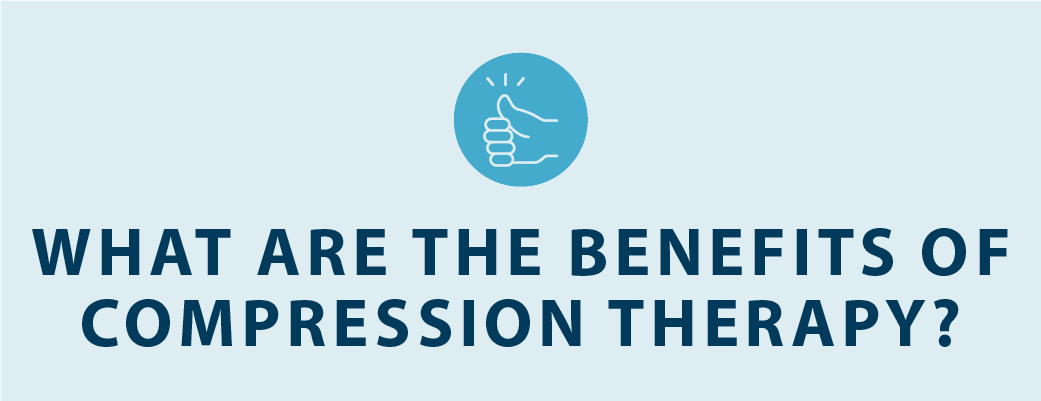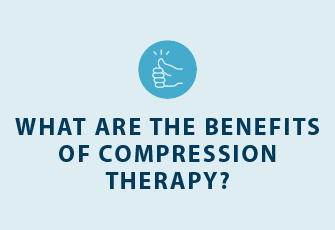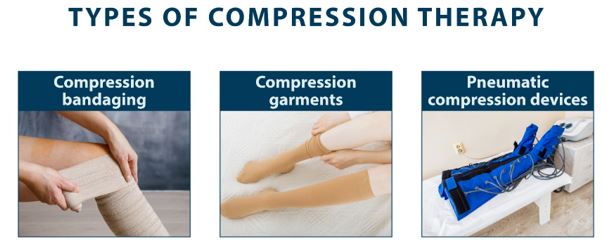What Are the Benefits of Compression Therapy?


Compression therapy can be a great way to get relief for people who suffer from pain and swelling due to edema or lymphedema. Compression therapy involves using garments, devices, pumps, or bandages to put pressure on an area, which can help encourage the flow of fluids to reduce swelling. If you want to know more about compression therapy benefits and how to use compression therapy, keep reading.
Compression Therapy with Tactile Medical’s Flexitouch Plus System
What Is Compression Therapy?
Compression therapy is a type of therapy that involves applying gentle pressure to help encourage the flow of fluids to reduce swelling. This is accomplished by using a device, bandage, pump, or garment to apply pressure. Compression therapy benefits are especially noticeable in the legs, where circulation problems are more common as a result of gravity.
Wearing compression garments for lymphedema or other similar medical conditions can provide you with relief from pain, swelling, itching, and other symptoms you may be experiencing. That being said, it’s always important to talk to your doctor before using compression therapy, especially if you’re planning on wearing compression stockings.
Compression Therapy Benefits
Compression is one of the cornerstones of complete decongestive therapy, which can help treat edema and lymphedema. So, what are the benefits of compression therapy? There are several benefits of leg compression therapy, including relief from symptoms, reduction in swelling, and improved circulation. Below, we’ll talk about some of the biggest benefits of compression therapy when it comes to treating and preventing lymphedema.
1. Improve blood circulation
Improved circulation is one of the biggest compression therapy benefits. Gravity and travel distance can make it difficult for blood to circulate from your legs back up to your heart, but compression therapy can help by using gentle pressure to encourage better circulation. Encouraging circulation through compression can help you prevent various complications that may come with edema and lymphedema. In addition to this benefit, you get relief from the symptoms that may be making your life a pain.
2. Reduce swelling
Another significant benefit of compression therapy is the fact that compression garments can help you reduce swelling. Swelling can lead to pain, discomfort, and decreased mobility in your legs and other affected areas, making it hard to get relief if you don’t have the time to lie down and keep your legs elevated. With compression therapy, you can get relief from swelling without having to change your daily routine, which means you may be able to keep working, playing with your kids, and performing your regular daily functions.
3. Relieve pain
Some people have edema and lymphedema with little to no pain, while other patients can experience pain along with swelling and poor circulation. Compression therapy benefits you by helping to relieve some of that pain, which makes it easier to get some exercise and live a normal life. Compression relieves pain because it encourages blood and fluid flow, which promotes healing.
Wearing the right compression garments can also help reduce your risk of complications such as blisters and ulcers. It’s not uncommon to treat edema blisters to get pain relief, but you don’t have to worry about that if you prevent them in the first place.
4. Promote recovery
When you’re living with a medical condition, especially edema or lymphedema, treating your condition is a top priority. One of the best things you can do to get on the path to recovery is to implement compression therapy as part of your treatment. Compression therapy benefits you by improving circulation, reducing swelling, reducing your risk of complications, and more, which are all key elements of recovery.
Compression raises the temperature of your skin, which, in turn, encourages blood flow. Rather than blood and fluid pooling in an area affected by lymphedema or an injury, compression allows that blood to recirculate and focus on repair. If you want to live a pain-free life with little to no swelling, compression therapy combined with other treatments is your best bet.
5. Reduce the risk of blood clots
Blood clots are a potentially fatal complication of circulation-related conditions, and you can reduce the risk of blood clots with compression garments. Blood clots occur because of poor circulation, which allows blood to clot as it remains in place. When these blood clots come loose, they can cause strokes and other medical emergencies. If you have blood circulation issues, edema or lymphedema, especially if you spend a lot of time sitting, compression garments can help you reduce your odds of getting blood clots.
6. Heal ulcers
Venous leg ulcers sometimes occur in patients with lymphedema or edema as a result of a circulatory issue. These ulcers can be painful and can lead to several complications, such as infection if left untreated. However, you can heal ulcers with a combination of dressing the wound and applying gentle pressure. Keep in mind that compression bandages should only be applied by a medical professional.
7. Manage lymphedema
Lymphedema and lipedema tend to progress over time, but compression garments can help you manage these conditions so they don’t worsen. Lymphatic massage can help you promote drainage while compression garments can help you keep swelling down and improve your circulation to reduce the complications you experience as a result of edema-related conditions. Plus, keeping swelling in check now can help prevent the progression of your condition down the road.

Compression therapy can also be used in conjunction with other treatment and management methods to reduce the symptoms and progression of lymphedema, such as manual lymphatic drainage, proper skin care, and light exercise.
Compression Therapy FAQs
When should compression therapy be used?
While there are numerous compression therapy benefits, it’s not always the right choice. Here’s when you should consider using compression therapy:
- Treating lymphedema: Compression therapy can help promote the flow of lymph, which can help treat lymphedema and provide relief from symptoms.
- During or after long flights or periods of standing: Long periods of sitting or standing can cause poor circulation, so compression therapy is effective at these times.
- Improve venous blood flow: If you have varicose veins as a result of a circulatory issue, compression therapy can help improve venous blood flow and provide some pain relief.
- Reducing swelling: Compression therapy can also help reduce swelling, providing relief from pain, itching, and other symptoms.
How often should you do compression therapy?
Deciding on an interval for compression therapy depends on your condition. You don’t want to overuse compression therapy, but you should use compression enough to experience the benefits. Make sure you talk to your doctor or lymphedema specialist to learn more about compression therapy benefits and how often you should use compression therapy. Generally speaking, you can use compression therapy daily. Your doctor can also provide other tips for treating your symptoms.
How long should you do compression therapy?
Similar to the previous question, deciding how long you should do compression therapy isn’t something you can necessarily determine on your own. If your doctor or a specialist recommends compression therapy, make sure you ask them how often you should be doing it and for how long.
What conditions can be treated or managed with compression therapy?
Compression therapy can help you manage and treat several conditions, including:
- Edema: By promoting circulation and reducing swelling, compression therapy benefits edema patients by providing symptom relief and reducing the risk of complications.
- Lymphedema: Compression therapy can also help promote the flow of lymph, which helps reduce swelling in lymphedema patients.
- Lipedema: Like other types of edema, lipedema swelling and pain can be relieved with compression therapy for most patients.
- Chronic venous insufficiency: Since CVI is a circulatory condition, compression therapy is a great way to improve and get relief from CVI.
- Blood clots: By helping to improve circulation, compression therapy reduces your risk of developing blood clots, as it makes it more difficult for blood to pool up in your veins.
- Ulcers: Leg ulcers can be treated with a combination of compression therapy and wound dressing.
What are the different types of compression therapy?
There are a handful of types of compression therapy to choose from, including:

- Compression bandaging: This process involves wrapping bandages to apply gentle pressure to relieve swelling. This should only be done by a medical professional or specialist.
- Compression garments: Compression garments include simple socks and sleeves you can wear to improve circulation and get relief from swelling.
- Pneumatic compression devices: Pneumatic compression devices, such as the Flexitouch Plus System, are worn for short periods of time and can provide rapid relief from swelling and edema symptoms.
Compression Therapy with Tactile Medical’s Flexitouch Plus System
Living with pain and swelling can make your life considerably more difficult, but compression therapy can help you get relief from edema, lymphedema, and lipedema. Fortunately, you can enjoy the compression therapy benefits today with the Flexitouch Plus System from Tactile Medical. This device is specially designed to help promote circulation and lymphatic drainage, so you get relief from swelling without wearing compression garments all day long. Plus, Flexitouch Plus is available for lower body treatment, upper body treatment, and even head and neck treatment, all of which can be used from the comfort of your home. Try the Flexitouch Plus System from Tactile Medical and see the difference compression therapy can make.